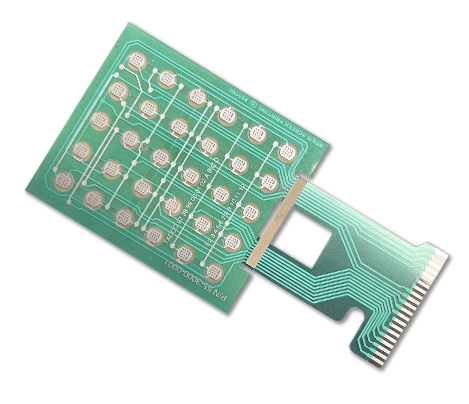Membrane Switches vs. Traditional Switches: What You Need to Know
Membrane Switches vs. Traditional Switches: What You Need to Know
Blog Article
Discover Just How Membrane Switches Function and Their Role in Modern Electronics
Membrane Switches represent an advanced assimilation of technology and style within the realm of contemporary electronics, working as important interfaces in countless tools. Comprised of several layers, these buttons make use of pressure-sensitive systems to assist in individual interaction. Their applications span different sectors, from customer electronics to clinical equipment, highlighting their adaptability and value. Recognizing the intricacies of Membrane switch functionality and their more comprehensive ramifications in enhancing individual experience welcomes additional expedition into their style, benefits, and the innovative growths forming their future in modern technology.
What Are Membrane Switches?

Membrane buttons are distinguished by their toughness and resistance to ecological aspects, such as dirt, dampness, and severe temperatures. They can be personalized with different graphics, colors, and responsive comments options, enhancing individual experience while maintaining visual allure - membrane switches. Additionally, the incorporation of printed circuits enables smooth assimilation right into devices, improving general performance.
The flexibility of Membrane switches appears in their capability to support both complex and basic control functions. They can include attributes such as LED signs and touch-sensitive technology, satisfying particular user needs. As modern technology remains to progress, Membrane Switches remain necessary for allowing reliable and instinctive individual interfaces, thereby playing a critical function in the development of modern electronic devices.
Elements of Membrane Buttons
Membrane buttons are composed of several key components that interact to create a practical and reputable user interface. The main elements include the graphic overlay, adhesive layer, spacer layer, and conductive traces.
The visuals overlay offers as the interface, generally printed on an adaptable substratum such as polyester or polycarbonate. This layer not only gives visual allure however additionally consists of tactile comments, visual cues, and safety attributes. Beneath the graphic overlay exists the glue layer, which safeguards the switch to the tool and makes certain toughness against environmental anxieties.
The spacer layer is vital for maintaining the necessary gap between the visuals overlay and the circuit layer. This gap permits the activation of the switch when pressure is used. The conductive traces, usually made from silver or carbon, develop the electrical pathways that finish the circuit when the switch is engaged.
Furthermore, a backing layer might be consisted of for structural assistance and insulation. These components team up seamlessly, ensuring that Membrane buttons are both resilient and user-friendly, making them important in various modern digital applications.
Just How Membrane Switches Work
Exactly how do Membrane Switches function effectively within digital devices? Membrane Switches operate on the principles of pressure-sensitive technology, using a split building and construction that includes visuals overlays, glue layers, and conductive elements.
The design of Membrane buttons is crucial for their efficient operation (membrane switches). The layers are meticulously engineered to provide tactile responses, toughness, and resistance to environmental elements such as dampness and dirt. The addition of domes-- small, increased locations within the button-- enhances responsive reaction, giving users with an obvious click sensation upon activation
Moreover, Membrane switches can be personalized in terms of dimension, form, and graphics, making them appropriate for various applications. They are often utilized in control panels, medical gadgets, and consumer electronics because of their sleek style and dependability. Generally, the effective performance of Membrane buttons is essential in improving user interaction and guaranteeing smooth operation in modern digital devices.

Applications in Modern Gadgets
Using their distinct layout and performance, Membrane switches have become important parts in a wide variety of modern-day digital tools. These flexible user interfaces are employed in consumer electronics, industrial tools, clinical gadgets, and automotive controls, supplying seamless user interaction.
In customer electronics, Membrane buttons are commonly located in devices like microwaves, cleaning devices, and other home gadgets, where they allow intuitive control with a smooth account. Their Discover More low-profile design helps with integration into compact tools, improving aesthetic allure without compromising functionality.
In commercial applications, Membrane Switches serve as control panels for equipment, using longevity and resistance to extreme settings. Their capability to withstand moisture and contaminants makes them suitable for use in production and processing sectors.
Clinical devices also take advantage of Membrane switches, which are designed to be simple to clean and keep, ensuring hygiene in clinical setups. They are frequently used in diagnostic equipment, person tracking systems, and mobile clinical gadgets, where integrity is critical.
Advantages of Membrane Switches
One of the vital benefits of Membrane you can look here buttons is their convenience, which allows them to be tailored for a range of applications throughout multiple sectors. These buttons can be made in different shapes and dimensions, accommodating distinct item demands while giving seamless integration right into devices. Their thin profile enables a compact and streamlined design, commonly boosting the aesthetic charm of digital products.
An additional considerable benefit is their toughness - membrane switches. Membrane buttons are generally resistant to dirt, moisture, and chemicals, making them suitable for rough settings. news This resilience prolongs their life expectancy contrasted to standard mechanical switches, decreasing the need for constant replacements
Furthermore, Membrane Switches deal cost-effectiveness. The manufacturing procedure includes printing technologies that decrease production costs, especially for big runs. This price, incorporated with low upkeep needs, makes them an appealing choice for manufacturers.

Conclusion
In conclusion, Membrane Switches stand for a significant development in customer interface innovation within contemporary electronic devices. As the need for intuitive and durable interfaces continues to grow, the duty of Membrane buttons in shaping user experience will unquestionably expand.
Membrane Switches stand for an advanced assimilation of innovation and design within the realm of modern electronics, serving as important interfaces in many gadgets.In the world of contemporary electronic devices, Membrane Switches serve as essential parts that assist in customer communication with devices. As modern technology proceeds to develop, Membrane Switches stay crucial for allowing reliable and intuitive individual interfaces, thus playing a pivotal function in the development of modern-day electronic tools.
Just how do Membrane Switches function successfully within electronic devices? Overall, the reliable functioning of Membrane switches is crucial in improving individual interaction and making sure seamless operation in contemporary digital tools.
Report this page